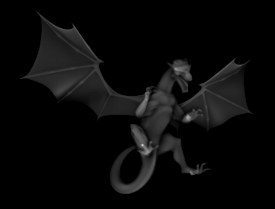
In this Topic Show
This help topic explains how to create an Emboss from Image feature. The entire process is explained step-by-step. Some special tips are provided, after the main portion of the tutorial, that show you how to take advantage of some new BobART features. The process shows you how to remove an unwanted area of the Emboss from Image feature to create a component. Without the new features, this special case would not be possible.
This tutorial combines four examples. You learn how to create an Emboss from Image, how to Vectorize geometry (Black and White Strategy), how to use Smoothing, and how to Save As a Component/STL. You can use the In This Topic links at the top of this page to navigate to each section if you are not completing the entire tutorial.
The BobCAD part file for this tutorial is available for download at: http://www.bobcad.com/helpfiles. If you are connected to the Internet, you can click the link provided to download and save the Emboss from Image Example 1.bbcd zip file. After downloading the zip file, extract the files on your system in a place that is easy to remember. After extracting the files, there are two images that you need to complete this tutorial.
The image needed for the Emboss from Image example, Dragon BAS.png, is shown next.

When creating emboss features, you can either define stock first using the Create/Modify Stock command, or you can add the feature first. When you add the feature first, you are automatically prompted to define the stock in the Stock Parameters dialog box.
For this example, you can open the Emboss from Image Example 1.bbcd file, or you can start from a new file.
1 In
the Data-CAM Tree Manager, click
the ![]() BobART Manager
tab.
BobART Manager
tab.
2 In
the BobART tree, right-click ![]() Emboss Model,
and click Emboss from Image.
Emboss Model,
and click Emboss from Image.
3 In the Open dialog box, navigate to the folder in which you saved the example files.
TIP: When locating an image file, it can be helpful to show all file types in the Open dialog box. This allows you to see all image files that are contained in each folder. To show all files: at the bottom of the Open dialog box, click the Files of Type arrow, and at the bottom of the list, select All Files.
Select Dragon BAS.png.
4 To open the image file, click Open.
The Stock Parameters dialog box is displayed.
In this example the stock is created with the same size as the image.
In the Model Size group, set the X value to 18.2361, and set the Y value to 13.8750.
You can increase the Model Size values if you want to make the stock larger than the image file. (The stock size can also be modified after creating the feature.)
5 The origin of the stock is the lower-left corner.
You can type the coordinate values of a point in the Origin XYZ boxes to define where the stock origin is located in the Workspace.
This example uses the default values of X0Y0Z0 to place the stock origin at the WCS or world coordinate system.
The default model color is used because the stock and the image are the same size.
In this situation, the color of the feature will cover (mask) the stock color.
6 To close the dialog box and create the stock, click OK.
The Create Emboss from Image dialog box is displayed.
1 For this example, the Origin values remain at X0Y0Z0.
As with the stock, the image origin is the lower-left corner of the image.
The Origin values define the position of the image in relation to the world coordinate system.
2 In the Model Size group, notice that the X Size and Y Size values are automatically set.
This is based on the size of the selected image file. You can use these parameters to modify the size of the emboss feature that is created from the image. (Remember that the stock size is also set to the same values.)
The Z Depth uses a default value of 0.100.
This defines the maximum height of the feature and it is not guaranteed to be exactly the specified value. (The information in the image defines the final result.)
3 Click in the Name box, and type My at the beginning of the description.
When the feature is added to the BobART tree, it is labeled My Image Emboss 1.
4 To select a color for the feature, click Color.
In the Color dialog box, click the desired color, or define a custom color, and click OK.
5 The Application Type, Add, is used for this example.
This means that the emboss is added to the model or raised in the positive Z-axis direction.
6 To create the feature using the defined values, click OK.
7 Right-click
![]() Emboss Model,
and click Regenerate.
Emboss Model,
and click Regenerate.
The result is shown next.
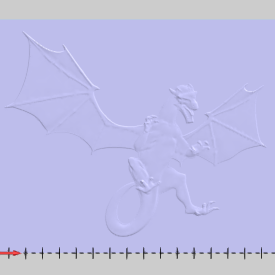
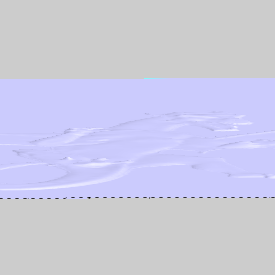
In the previous image, the maximum height in Z is less than 0.100.
The default value of 0.100 is small for this example.
The next step is to modify the Z Depth.
1 In
the BobART tree, right-click ![]() My Image Emboss 1,
and click Edit.
My Image Emboss 1,
and click Edit.
2 In the Model Size group, set the Z Depth to 1.00.
3 To accept the change, click OK.
Notice the feature in the BobART tree. The ![]() Emboss Model icon and the
Emboss Model icon and the ![]() My Image
Emboss 1 icon are displayed with a red x. This shows that changes have
been made that have not been added to the model. The model needs to be
regenerated.
My Image
Emboss 1 icon are displayed with a red x. This shows that changes have
been made that have not been added to the model. The model needs to be
regenerated.
4 To
add the changes to the model, right-click ![]() Emboss
Model, and click Regenerate.
Emboss
Model, and click Regenerate.
NOTE: Every time that you modify the parameters or the geometry/image of an emboss feature, the results are not added to the model until you Regenerate to calculate the changes.
The maximum Z Depth of the feature is now 1.00.
Notice that the emboss is much more prominent than in the previous result.
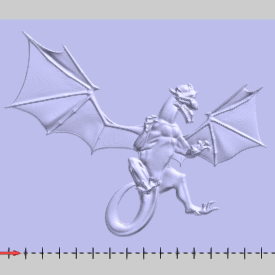
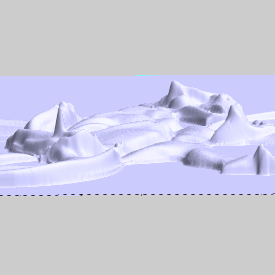
The Emboss from Image example is complete.
In the next part of this tutorial, you learn how to Vectorize an image that is used to create the profile of the dragon. The geometry is then used to contain a Smoothing feature. This geometry is also used to create an emboss feature that contains all of the areas around the dragon. After creating the second feature, the dragon can then be saved as a component that only contains the dragon.
For this part of the tutorial, a black and white image of the dragon is loaded into the system and vectorized to create geometry that is used later.
1 To
hide the current embossed model, right-click ![]() Emboss Model, and click Blank/Unblank.
Emboss Model, and click Blank/Unblank.
2 In
the ![]() BobART
tree, right-click
BobART
tree, right-click ![]() Images, and click Load
Image.
Images, and click Load
Image.
3 In the Open dialog box, locate and select Dragon Black and White.png, and click Open.
TIP: When locating an image file, it can be helpful to show all file types in the Open dialog box. This allows you to see all image files that are contained in each folder. To show all files: at the bottom of the Open dialog box, click the Files of Type arrow, and at the bottom of the list, select All Files.
The image is loaded into the workspace with the
image origin (the lower-left corner) placed at the WCS or world coordinate
system origin. (If you want to change the default location, right-click
![]() Image-image name,
and click Change Origin.)
Image-image name,
and click Change Origin.)
IMPORTANT: When viewing images in the Workspace, the Top view must be used (press Ctrl+1). When you rotate to any other viewing position, the image is no longer visible.
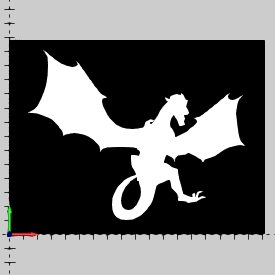
4 Under
![]() Images,
right-click
Images,
right-click ![]() Image-Dragon
Black and White, and click Vectorize.
Image-Dragon
Black and White, and click Vectorize.
The Raster to Vector dialog box is displayed.
5 In the Vectorize Strategy group, select 2-Level (Black/White) Strategy.
The Threshold Value is set to 2. (For this example, no changes are made to the default settings.)
6 To vectorize the image using the defined parameters, click OK.
7 To
hide the image and view the geometry, right-click ![]() Image-Dragon Black and White,
and click Blank/Unblank.
Image-Dragon Black and White,
and click Blank/Unblank.
[You can also use the keyboard shortcut I (the letter I, for Image). Click anywhere in the Workspace (so that it has key focus) and press I to toggle the visibility of the image. This method can be used instead of using the Blank/Unblank method, meaning that they do not work together. You use one or the other.]
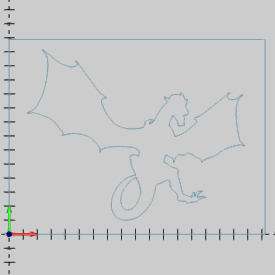
This concludes the vectorization example. The geometry that you created is used in the next three parts.
When you zoom-in to view the model up close, you can see that the result of embossing the height-map image has left a texture/grainy appearance on the model. This appearance may or may not be desired. For this example, we use smoothing to remove this from the model surface. The areas of the model that we want to improve are shown next.
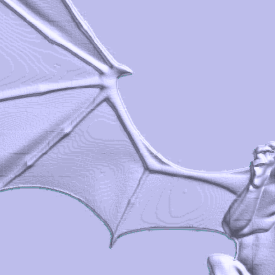
1 Right-click
![]() Emboss Model,
and click Smoothing.
Emboss Model,
and click Smoothing.
2 In the Boundary Based Smoothing dialog box, leave the default settings, and click OK.
3 In
the BobART tree, under ![]() Smoothing
2, right-click
Smoothing
2, right-click ![]() Geometry, and click Re/Select.
Geometry, and click Re/Select.
Press and hold Shift, and click anywhere along the profile of the dragon as shown next.
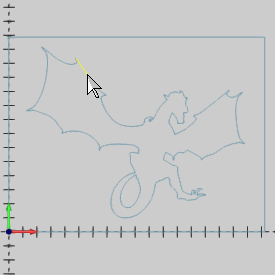
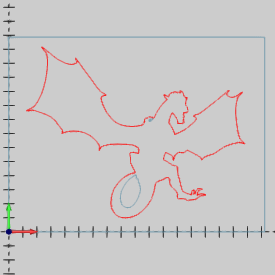
Press and hold Shift, and click anywhere along the following chain.
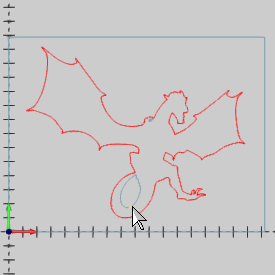
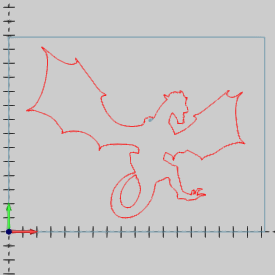
To confirm the geometry selections, press the Spacebar. (You can also click ![]() OK.)
OK.)
TIP: When using a Smoothing feature, by default, the smoothing is applied to the entire model. (You do not have to select geometry.) When you select geometry to contain the smoothing feature, it is only applied within the selected boundaries.
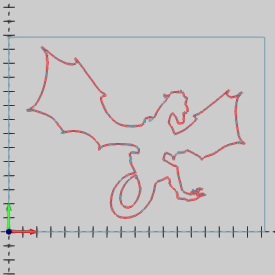
To show the embossed model again, right-click Emboss Model, and click Blank/Unblank.
4 To
update the model, right-click ![]() Emboss Model, and click Regenerate.
Emboss Model, and click Regenerate.
The result is shown next.
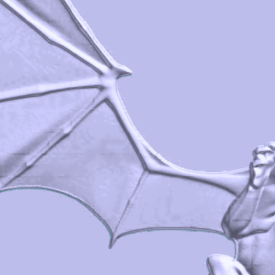
You can see that the surface of the model has been improved, but it can still be improved further.
5 In
the BobART tree, right-click ![]() Smoothing, and
click Edit.
Smoothing, and
click Edit.
In the Smoothing Parameters group, change the Smoothing Window Size to 0.100.
This increases the amount of smoothing applied.
6 To update the change, Regenerate the model (as in Step 4).
The result is shown next.
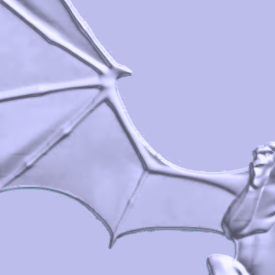
The surface of the model has been greatly improved and the smoothing is now complete. This concludes the Smoothing portion of this tutorial.
In the next part of this tutorial, you create an Emboss Regular feature. The geometry that was created from the boundary of the image is the same size as the model/feature. Because they are the exact same size, you offset the geometry to assure that no artifacts are created at the edge of the model.
1 In the Other menu, click Offset.
Press E to hide the embossed model.
2 In
the ![]() Data Entry
tab, set the Distance to 0.125.
Data Entry
tab, set the Distance to 0.125.
3 Press and hold Shift, and in the Workspace, click near the top left of the rectangle as shown next.
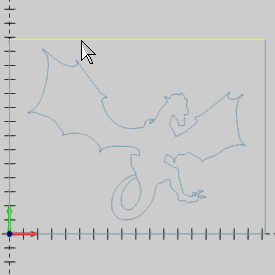
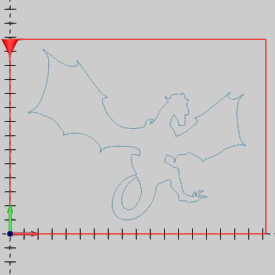
To confirm the selection, click ![]() OK.
OK.
The CAD preview shows the offset inside of the rectangle.
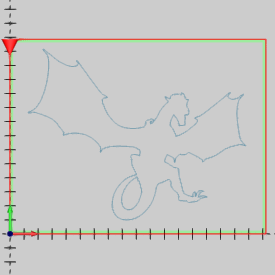
To reverse the direction of the offset, in the Data Entry tab, click Right Side of Chain.
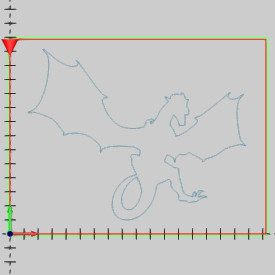
To create the offset as shown in the CAD preview, in the Data Entry tab, click OK.
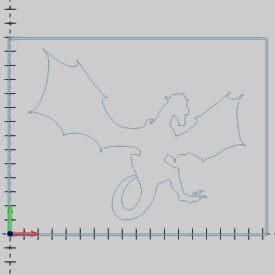
To cancel the Offset function, click Cancel.
4 To enable selection mode, in the Edit menu, click Select Mode.
Zoom in to view the outer profile.
Press and hold Shift, and click anywhere on the inner rectangle.
Make sure to select the smaller rectangle and not the offset that you just created.
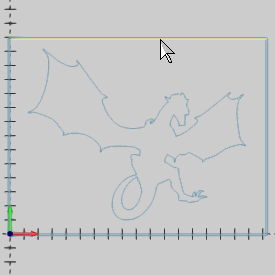
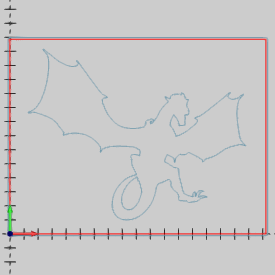
To remove the geometry, in the Edit menu, click Delete.
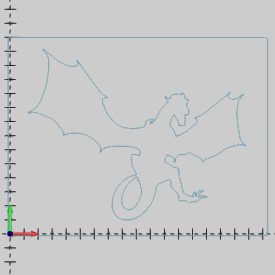
Now the boundary that is used to create the Emboss Regular feature is larger than the model.
This assures that the Emboss Regular feature covers all unwanted areas of the model.
For this part of the tutorial, a regular emboss feature is created that contains all of the unwanted areas of the Emboss from Image feature. This allows us to save only the area of the dragon as a component/stl.
1 In
the BobART tab, right-click ![]() Emboss Model,
and click Emboss Regular.
Emboss Model,
and click Emboss Regular.
2 In the Emboss dialog box, click Color.
Select a new color for the feature, and click OK.
In the Emboss dialog box, click OK. (The parameters for this feature are not important, so the default values are used.)
3 Under
![]() Regular Emboss
3 - Add, right-click
Regular Emboss
3 - Add, right-click ![]() Geometry, and click Re/Select.
Geometry, and click Re/Select.
4 To chain select the entities, press and hold Shift, and click the entities as shown next.
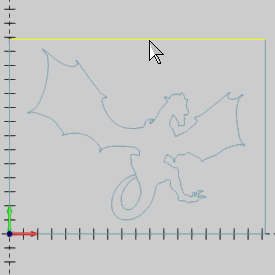
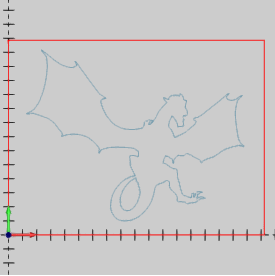
Continue to hold Shift, and click anywhere along the profile of the dragon as shown next.
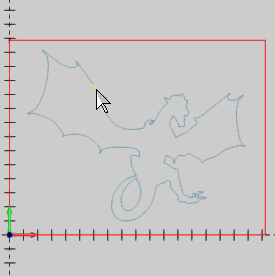
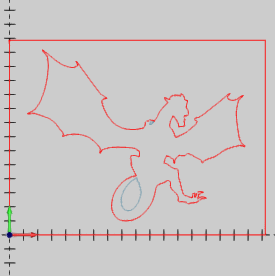
Continue to hold Shift, and click the following entity.
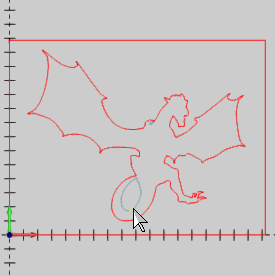
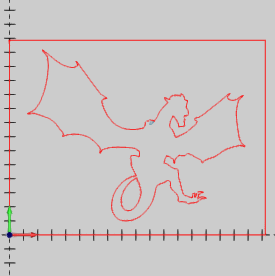
5 To
confirm the selections, click ![]() OK. (You can also press the Spacebar.)
OK. (You can also press the Spacebar.)
6 To add the changes to the model, right-click Emboss Model, and click Regenerate.
7 To show the model and view the results, press E.
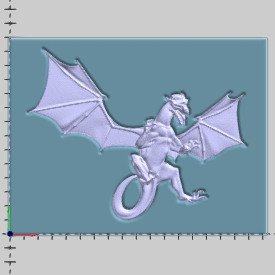
The model now contains two emboss features, the original Emboss from Image and the Regular Emboss that was added to surround the dragon emboss. When you save an individual emboss as a component, only the area defined by the selected feature is saved. Because the Regular Emboss covers all of the area around the dragon, it is not included when saving the Emboss from Image as a component/.stl file.
When the stock is created for emboss features, the Resolution is automatically set based on the size of the stock. You can increase the Resolution some to help improve the model appearance. You may otherwise want to lower the resolution to achieve a different appearance or to conserve system resources during the creation process.
TIP: The Resolution parameter that is found in the Stock Parameters dialog box is the DPI, or dots per inch, of the model. When increasing the resolution, you must remain within reasonable limits to avoid running out of system resources. Larger resolutions require more processing power and may not be beneficial in the end result when machining the model. The level of detail in the model only needs to match the level of detail with which it is machined.
1 In
the ![]() BobART
tree, right-click
BobART
tree, right-click ![]() Emboss Model, and click Create/Modify
Stock.
Emboss Model, and click Create/Modify
Stock.
2 In the Stock Parameters dialog box, notice the value in the Resolution box.
For this example, the resolution is currently 72.
Just to see how the resolution is updated, in the Model Size group, change the X value to 20.00, and press Tab.
The resolution is updated based on the model size.
(Change the X value back to 18.2361.)
3 In the Resolution box, type 125.
4 To close the dialog box, click OK.
5 To
update the model, right-click ![]() Emboss Model, and click Regenerate.
Emboss Model, and click Regenerate.
(Calculation times increase when the resolution is increased.)
The increased resolution for this example actually starts to cause a grainy appearance to return, which was removed earlier by the Smoothing feature. (Increasing the Resolution creates a more detailed model. In this case, the increase does not improve the appearance of the model.)
Before saving the component in the next part, change the Resolution back to 72.00, and Regenerate the model (as explained in Steps 1-5).
The BobART module now includes the ability to save individual emboss features (or the entire model) as a component. Saving as a component means that the feature (or model) is saved as an .stl file. The component can then be used to create an Emboss from Component feature. The following steps are used to create a component from a single feature.
1 In
the ![]() BobART
tree, right-click the top level item of the feature.
BobART
tree, right-click the top level item of the feature.
For this example, right-click ![]() My Image Emboss 1, and click Save as Component/STL.
My Image Emboss 1, and click Save as Component/STL.
2 In the STL Save Option dialog box, click OK. The default tolerance value is used.
TIP: You can decrease the tolerance (make the value smaller) to create a more accurate model if necessary. However, decreasing the tolerance increases the size of the saved file, and it may not actually be necessary (meaning that it doesn't improve the machining of the part). The default tolerance is a good starting point. You can increase the tolerance (for example, to 0.001) to create a smaller file size without significant degradation to the model. You should experiment until you find the best result for your parts.
3 In the Save As dialog box, select the folder in which you would like to save the component.
4 In the File Name box, type the name of the component.
For this example, type My Dragon Component.
5 To save the file, click Save.
The result of the component is shown next. (The component was opened in a new file to show the result.)
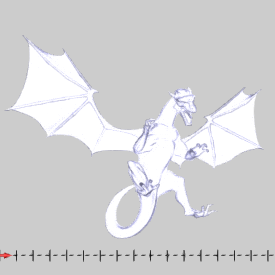
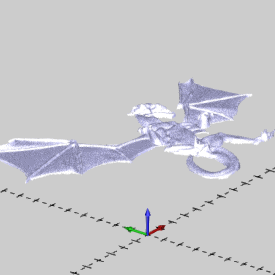
The component is finished. This concludes the How to Create a Component portion of this tutorial.
The component is used in the How to Create an Emboss from Component tutorial.
To learn how to save the entire model as a component, view How to Save Whole Emboss As Component/STL.
This section explains why the process used in this example was necessary to create the dragon component from the Emboss from Image feature (using only a specific area of the feature).
It is important to understand why the process used in this tutorial was applied to remove the areas around the dragon. The BobART module now includes the ability to remove the non-embossed areas of an embossed model. This option, Remove Non-Emboss Area, is found in the Stock Parameters dialog box. This option can remove excess stock (that is larger than the Emboss from Image feature), however, it does not have an effect on the Emboss from Image feature itself, because the entire area of the image is a part of the emboss.
Another new feature in BobART is the ability to create components using the entire model (Save Whole Emboss As Component/STL) or individual emboss features (Save as Component/STL). The Save as Component/STL option saves only the area defined by the selected feature. Any additional emboss contained within the same area is not included in the component. This is the reason that the Regular Emboss was added to the embossed model. The Regular Emboss feature covered all of the undesired areas around the dragon. When the Emboss from Image feature is saved as a component/.stl file, none of the areas contained in the regular emboss are included in the component.
How to Create an Emboss from Component